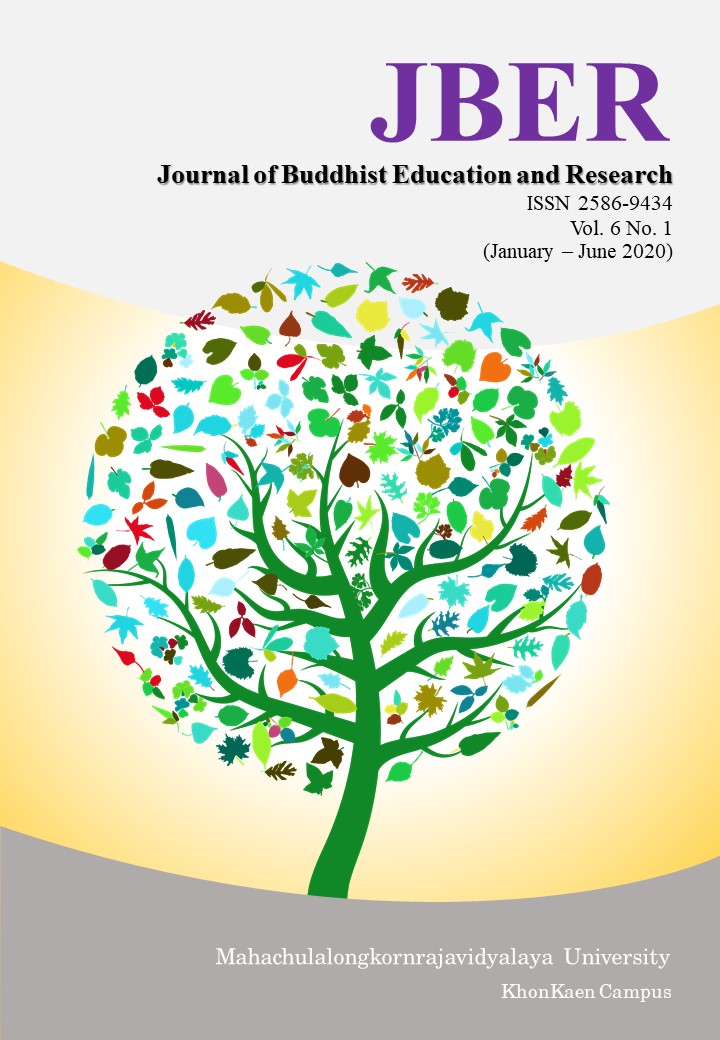LERNING MANAGEMENT TO LIVE TOGETER BASED ON THE FOUR SANGAHAVATTHU OF STUDENTS AT CHUMCHONBANNADEE - NONGPHAI SCHOOL SAKHONNAKHON PROVINCE
Keywords:
learning management, Live Together, Four SangahavatthuAbstract
The aims of this research were: to study the general conditions; to compare and present the ways of learning management for co-existence in accordance with IV Sangahavatthu dhammas (saṅgahavatthu, bases of social solidarity) of the students at Chumchonbannadee-Nongphai school, Sakonnakon province. This study was carried out by means of a mixed research methodology. For the qualitative research, the interview form and questionnaire were used to collect the data from 128 samples selected by Krejcies and Morgan method.
The research results were as follows:
1) The learning management for co-existence in accordance with IV Sangahavatthu dhammas of the students at Chumchonbannadee-Nongphai school, Sakonnakon province was statistically rated at the least level in overall. All respectively studied aspects: 1) samānattatā (equality consisting in impartiality); 2) dāna (giving); 3) piyavācā (kindly speech); 4) atthacariyā (useful conduct) were rated at the same level.
2) The comparative analysis of the learning management for co-existence in accordance with IV Sangahavatthu dhammas of the students at Chumchonbannadee-Nongphai school, Sakonnakon province revealed the low statistic score in overall ( = 2.23,S.D.=0.35), all aspected ranked from the aspect of samānattatā ( = 2.34,S.D.= 0.39), dāna ( =2.34,S.D.= 0.39), piyavācā ( =2.28,S.D.=0.39), atthacariyā ( =1.96,S.D.=0.47), samānattatā (equality consisting in impartiality) were rated at the same level. Classified by the class levels, tested by f-test in overall, there was no significant statistic difference at the level of .05. Classified by grades and parental occupations, the score was the same. This was inconsistent with the set hypothesis.
References
เปรมปวีร์ รักความซื่อ. (2561). การบริหารงานวิชาการแบบมีส่วนร่วมของชุมชนตามหลักสังคหวัตถุ 4 โรงเรียนประถมศึกษาสังกัดองค์การบริหารส่วนจังหวัดนนทบุรี กลุ่ม 1. วิทยานิพนธ์พุทธศาสตรมหาบัณฑิต. บัณฑิตวิทยาลัย มหาวิทยาลัยมหาจุฬาลงกรณราชวิทยาลัย.
พระธนพร คุณสมฺปนฺโน (อาคะนิช) และคณะ. (2561). การประยุกต์ใช้หลักสังคหวัตถุ 4 ในการดำเนินชีวิตประจำวันของประชาชนบ้านศิลา ตำบลศิลา อำเภอเมืองขอนแก่น จังหวัดขอนแก่น. วิจัยรัฐศาสตรบัณฑิต. มหาวิทยาลัยมหามกุฏราชวิทยาลัย.
พระมานพ จิตฺตสํวโร (เสือแก้ว). (2555). ความคิดเห็นของประชาชนที่มีต่อการนำหลักสังคหวัตถุ 4 มาใช้ในการบริการประชาชนของอาสาสมัครกู้ภัยใต้เต็กเซี่ยงตึ๊ง จังหวัดนครศรีธรรมราช. วิทยานิพนธ์พุทธศาสตรมหาบัณฑิต. บัณฑิตวิทยาลัย มหาวิทยาลัยมหาจุฬาลงกรณราชวิทยาลัย.
พระสุนทร ธมฺมวโร (บุญคง). (2560). การประยุกต์ใช้หลักสังคหวัตถุ 4 ในชุมชนวัดหนองสนม จังหวัดระยอง. วิทยานิพนธ์พุทธศาสตรมหาบัณฑิต. บัณฑิตวิทยาลัยมหาวิทยาลัยมหาจุฬาลงกรณราชวิทยาลัย.
ไพฑูรย์ ขุนอาสา. (2532). ผู้บริหารกับการใช้สังคหวัตถุธรรม: ศึกษากรณีผู้บริหารโรงเรียนประถมศึกษา สังกัดสำนักงานการประถมศึกษาอำเภอเมือง จังหวัดอุตรดิตถ์. วิทยานิพนธ์ศึกษาศาสตรมหาบัณฑิต. บัณฑิตวิทยาลัย มหาวิทยาลัยเชียงใหม่.
มหาวิทยาลัยมหาจุฬาลงกรณราชวิทยาลัย. (2539). พระไตรปิฎกภาษาไทย ฉบับมหาจุฬาลงกรณราชวิทยาลัย. กรุงเทพฯ: โรงพิมพ์มหาวิทยาลัยมหาจุฬาลงกรณราชวิทยาลัย.





